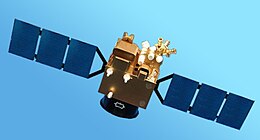Tianhui 1B
 From Wikipedia - Reading time: 6 min
From Wikipedia - Reading time: 6 min
 Tianhui I-02 | |
| Mission type | Earth observation |
|---|---|
| Operator | CASC |
| COSPAR ID | 2012-020A |
| SATCAT no. | 38256 |
| Start of mission | |
| Launch date | 6 May 2012, 07:10:05 UTC |
| Rocket | Chang Zheng 2D |
| Launch site | Jiuquan LA-4/SLS-2 |
| Orbital parameters | |
| Reference system | Geocentric |
| Regime | Low Earth |
| Perigee altitude | 492 kilometres (306 mi)[1][2] |
| Apogee altitude | 504 kilometres (313 mi)[1][2] |
| Inclination | 97.35 degrees[2] |
| Period | 94.57 minutes[3] |
| Epoch | 6 May 2012[3] |
Tian Hui-1 (also known as Mapping Satellite I) is a Chinese Earth observation satellite built by Dong Feng Hong, a China Aerospace Science and Technology Corporation (CASC). Tian Hui-1 was launched on 6 May 2012 at 9:10 UTC on a Long March 2D rocket into a Sun-synchronous, polar orbit with an perigee of 490 km (300 mi) and apogee of 505 km (314 mi).[4]
According to the Chinese Ministry of Defense the new satellite carries scientific experiments and is to be used for the evaluation of ground resources and mapping.[5]
Tian Hui 1 is equipped with two different camera systems in the visible and infrared range. The visible light camera is able to produce three-dimensional pictures in the spectral region between 510 and 690 nanometers with a dissolution of approximately 5 meters and a field of view of approximately 25 degrees. The infrared camera reaches a dissolution of approximately 10 meters and covers four wavelengths (430 - 520 Nm, 520 - 610 Nm, 610 - 690 Nm and 760 - 900 Nm).[5]
See also
[edit]References
[edit]- ^ a b "TH 1". Gunters Space Page. Retrieved 8 March 2013.
- ^ a b c "TianHui 1B". Space New Feed. Space News Feed.
- ^ a b McDowell, Jonathan. "Satellite Catalog". Jonathan's Space Page. Retrieved 3 May 2018.
- ^ "Chinese Mapping Satellite Successfully Launched to Orbit". Space.com. 8 May 2012. Retrieved 8 March 2013.
- ^ a b "China launches Tianhui-1B via Long March 2D". NASA spaceflight. 6 May 2012. Retrieved 8 March 2013.
 KSF
KSF